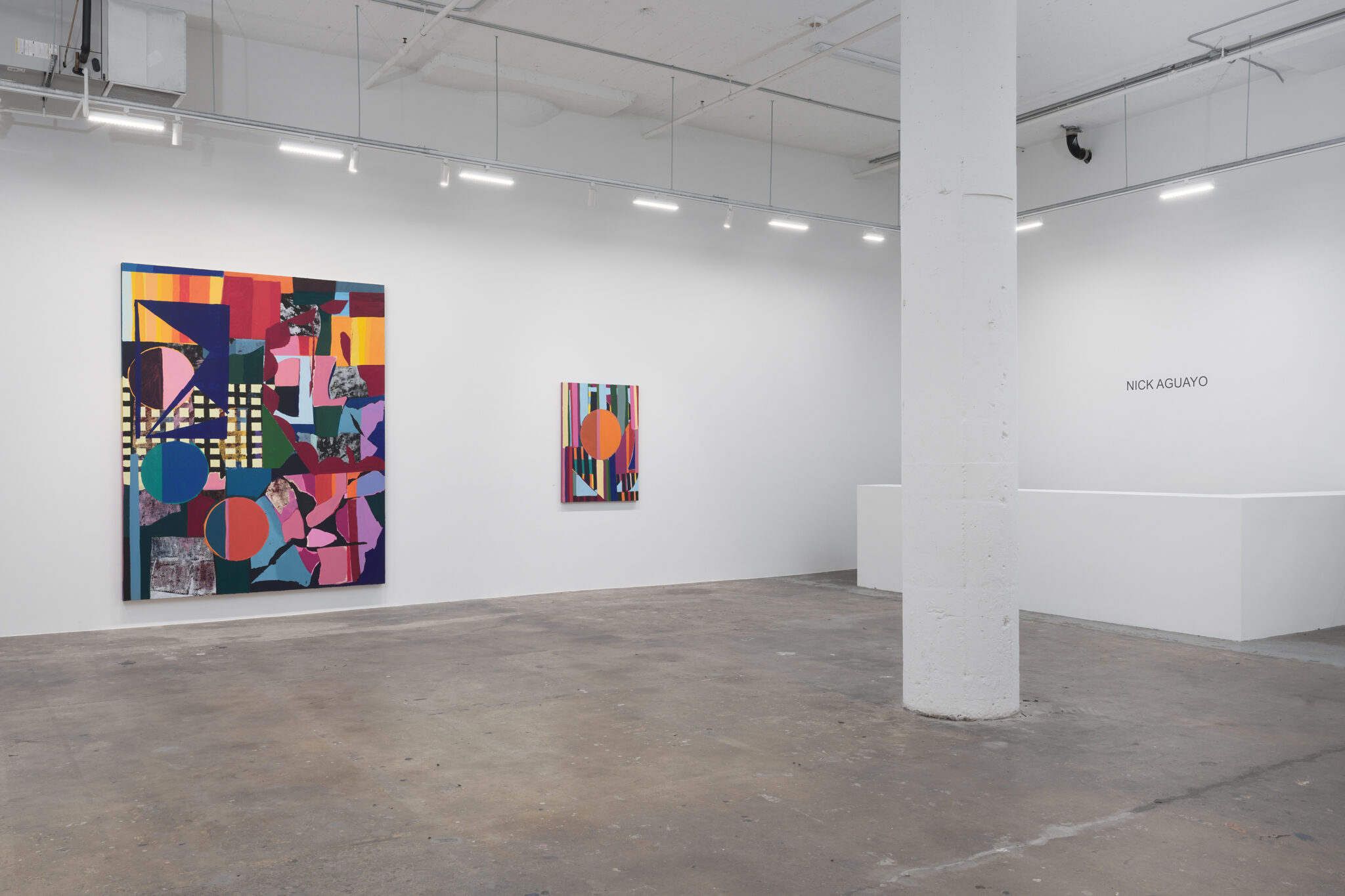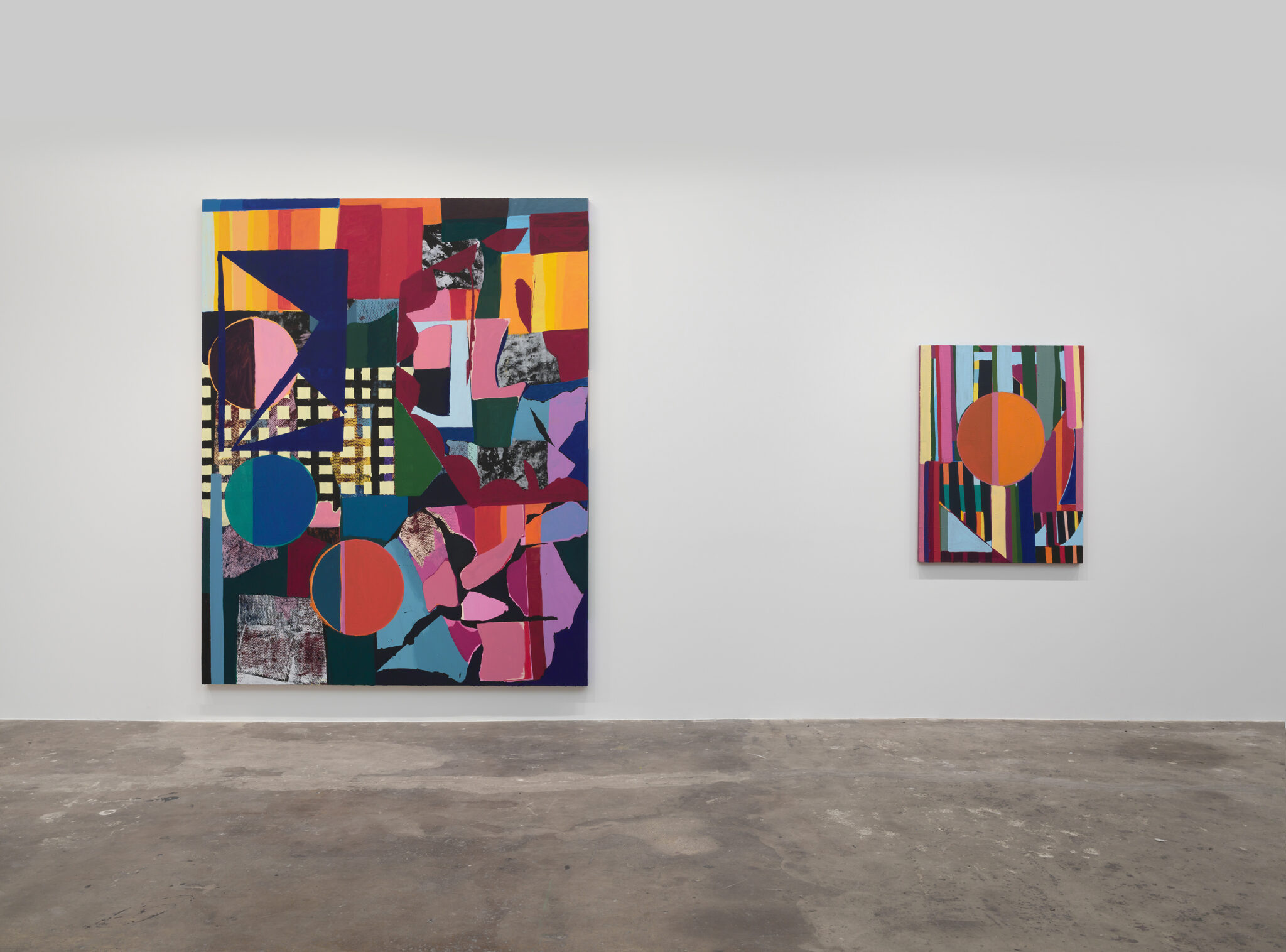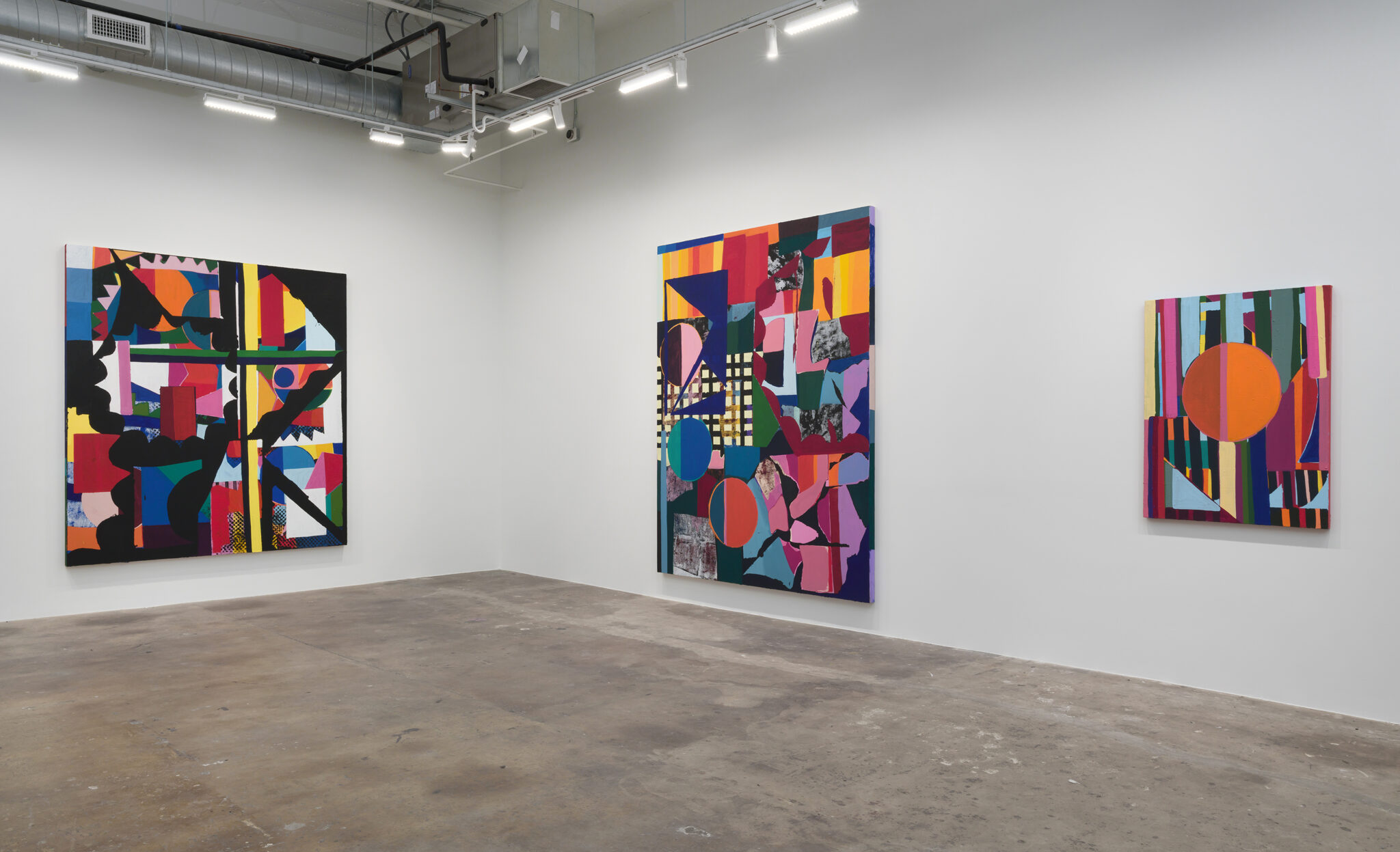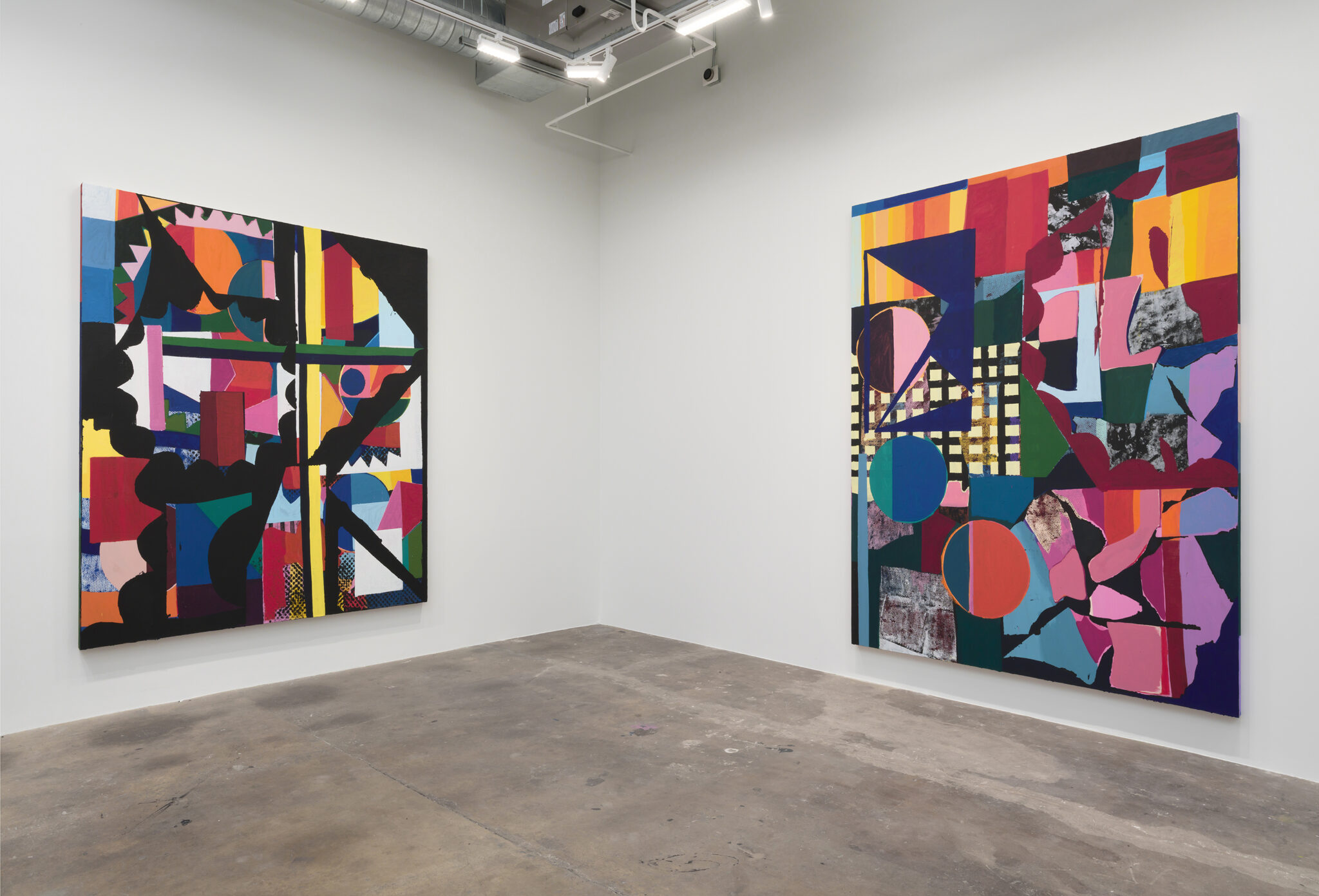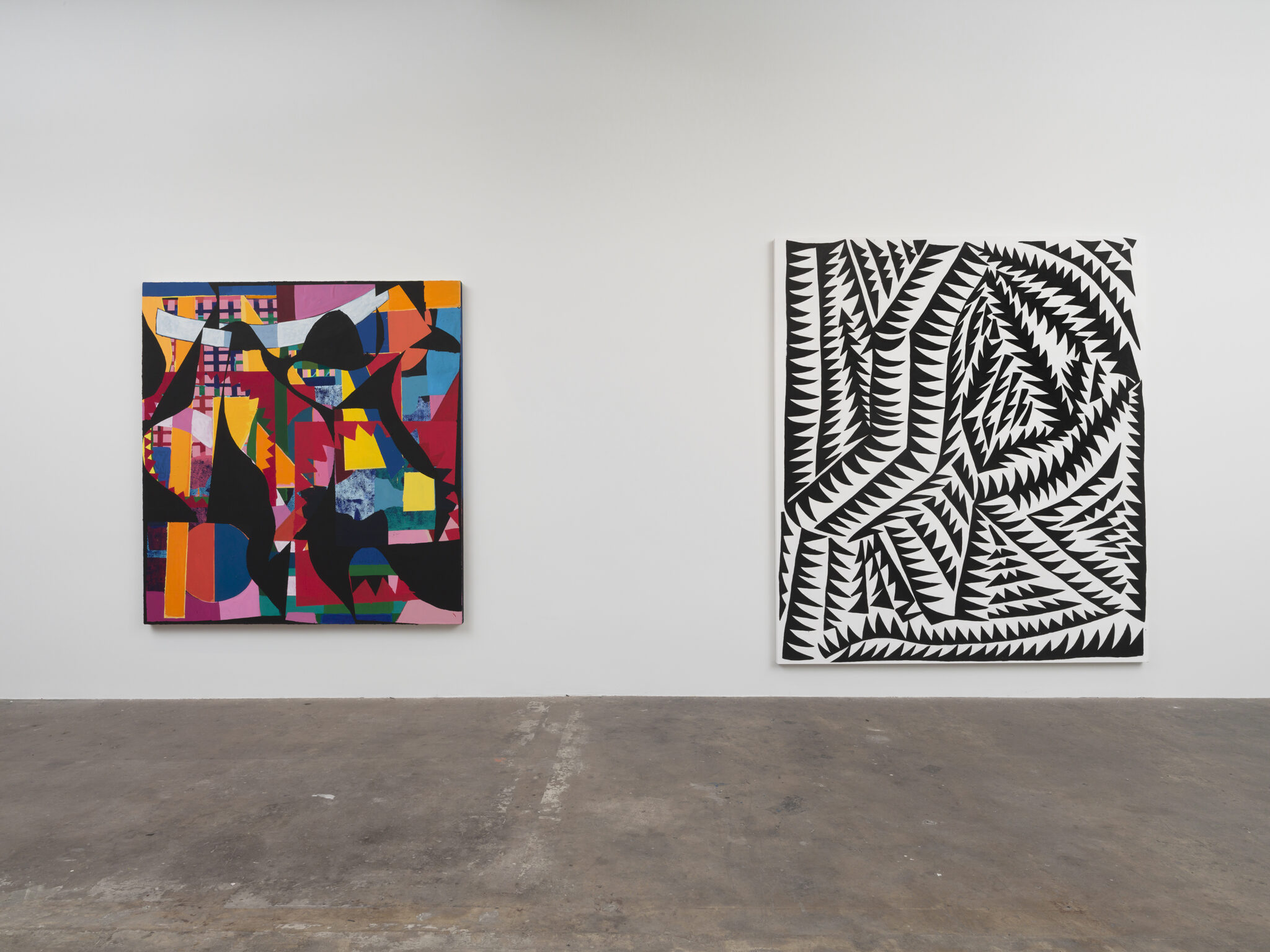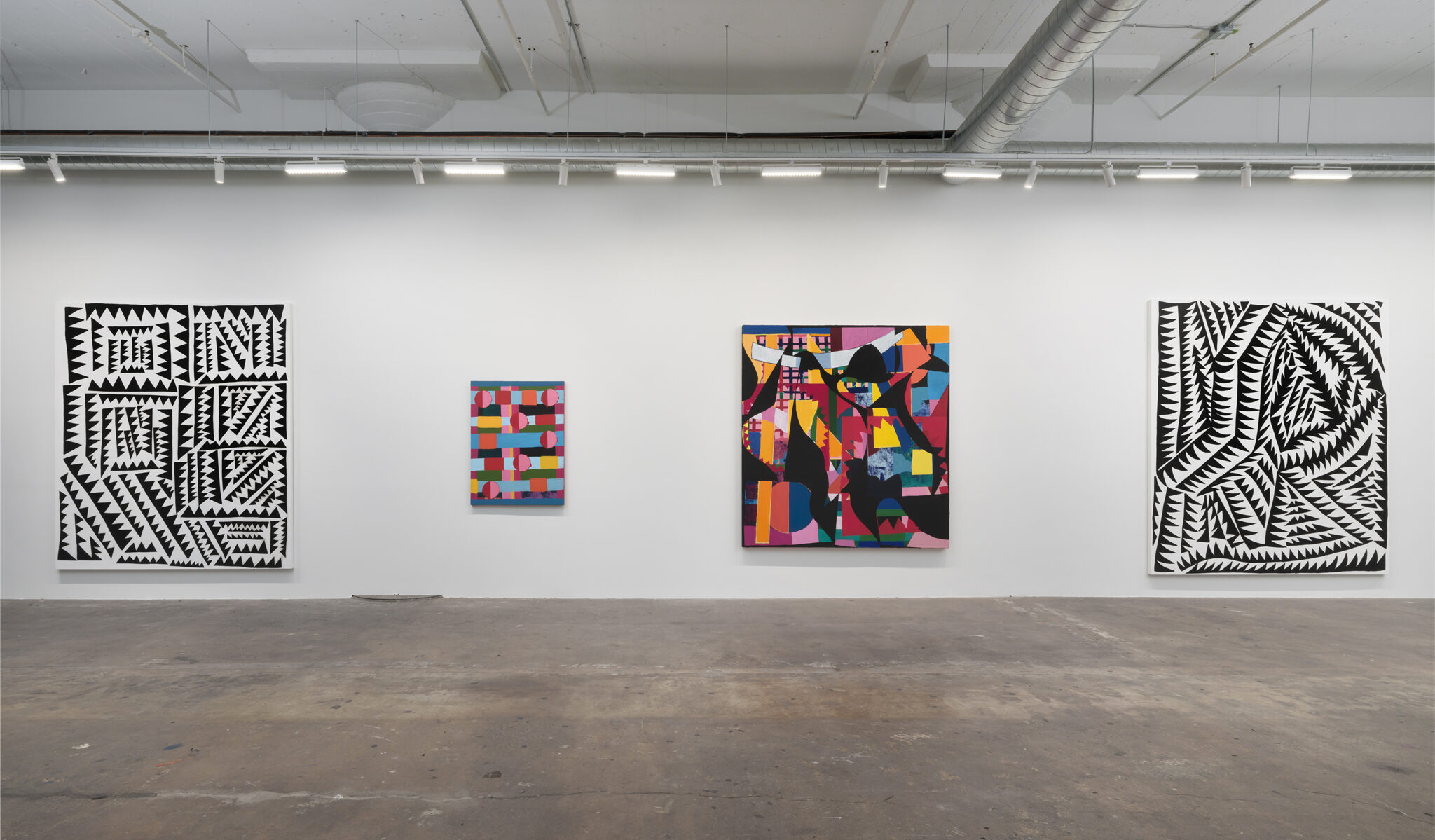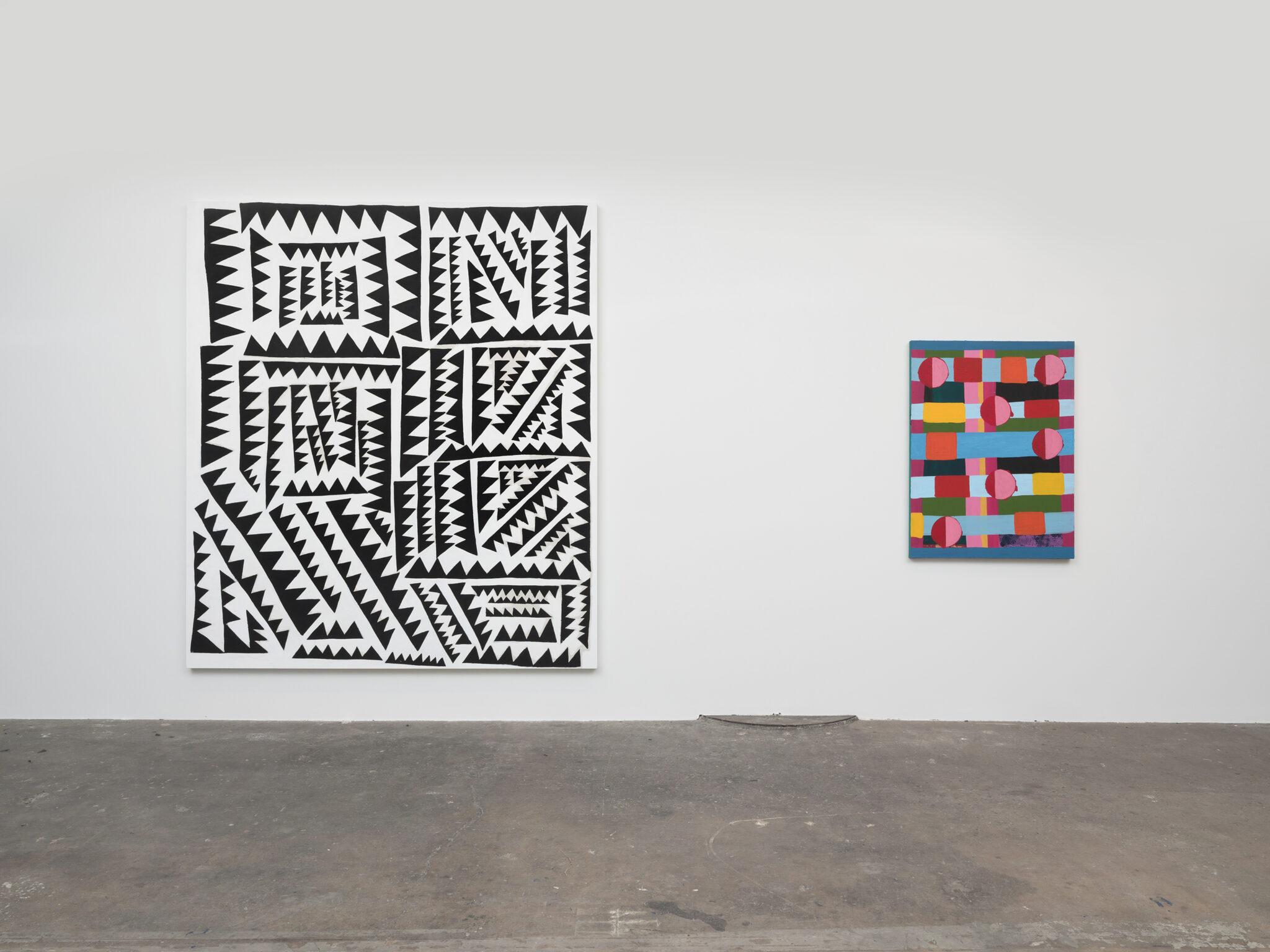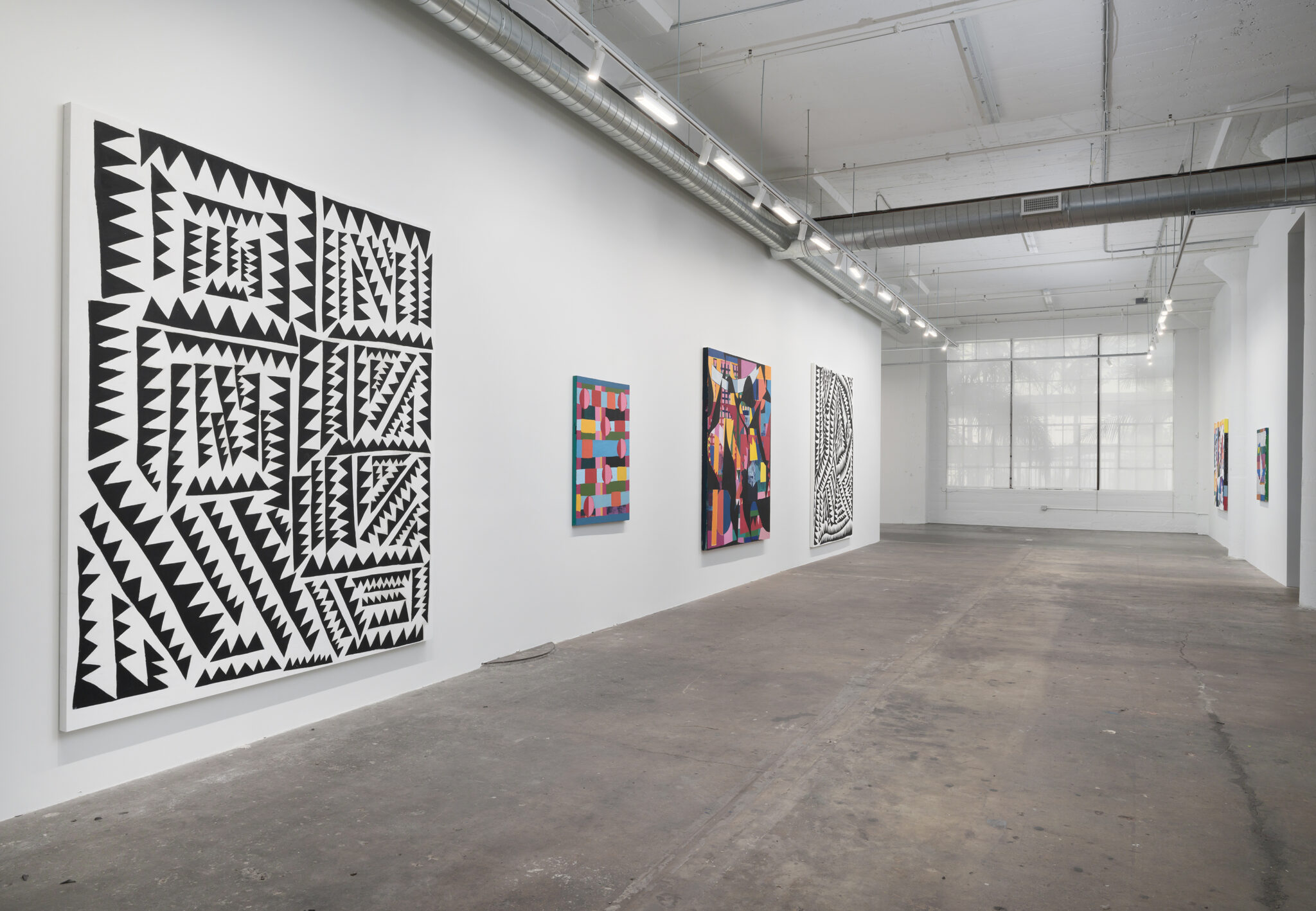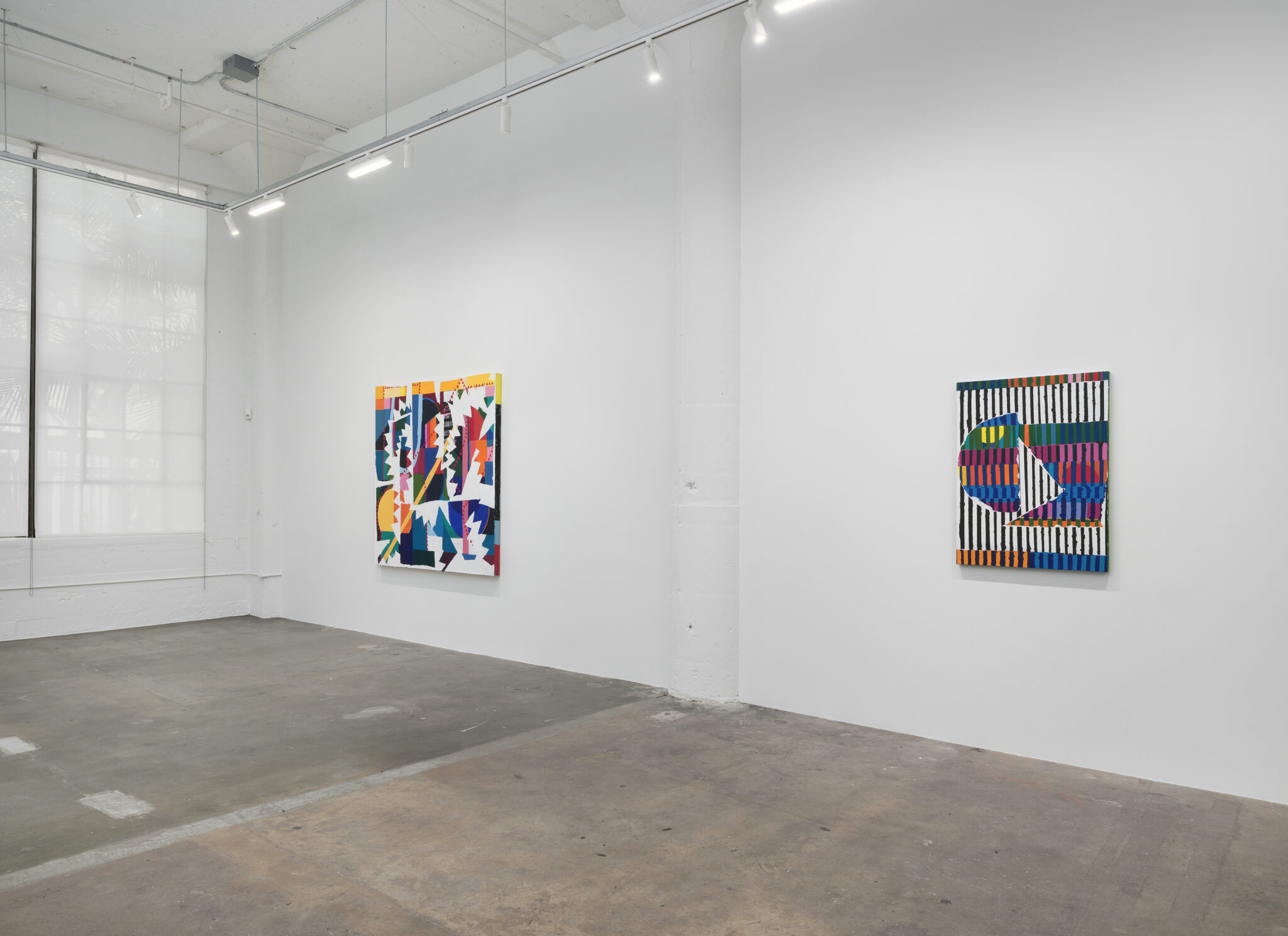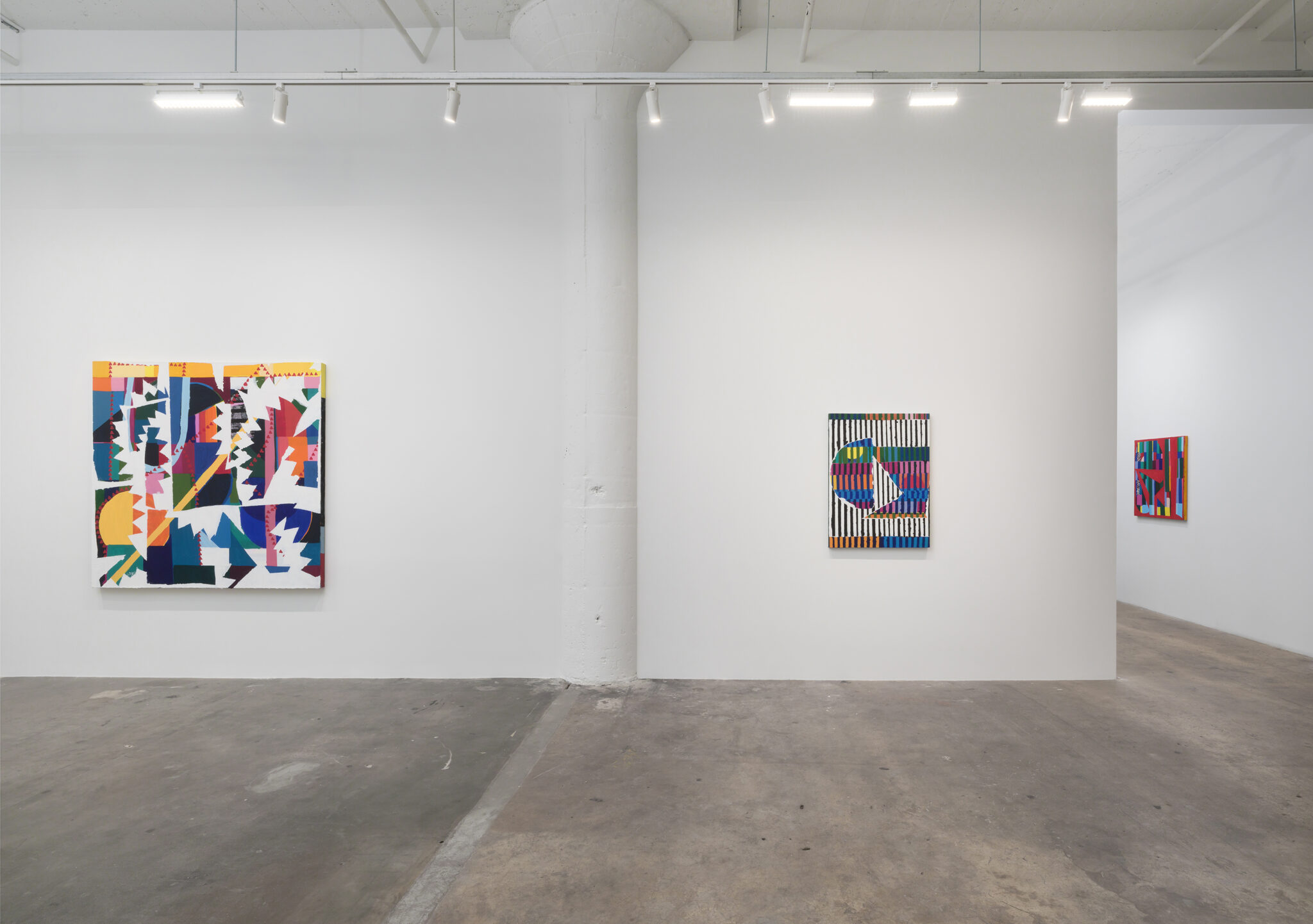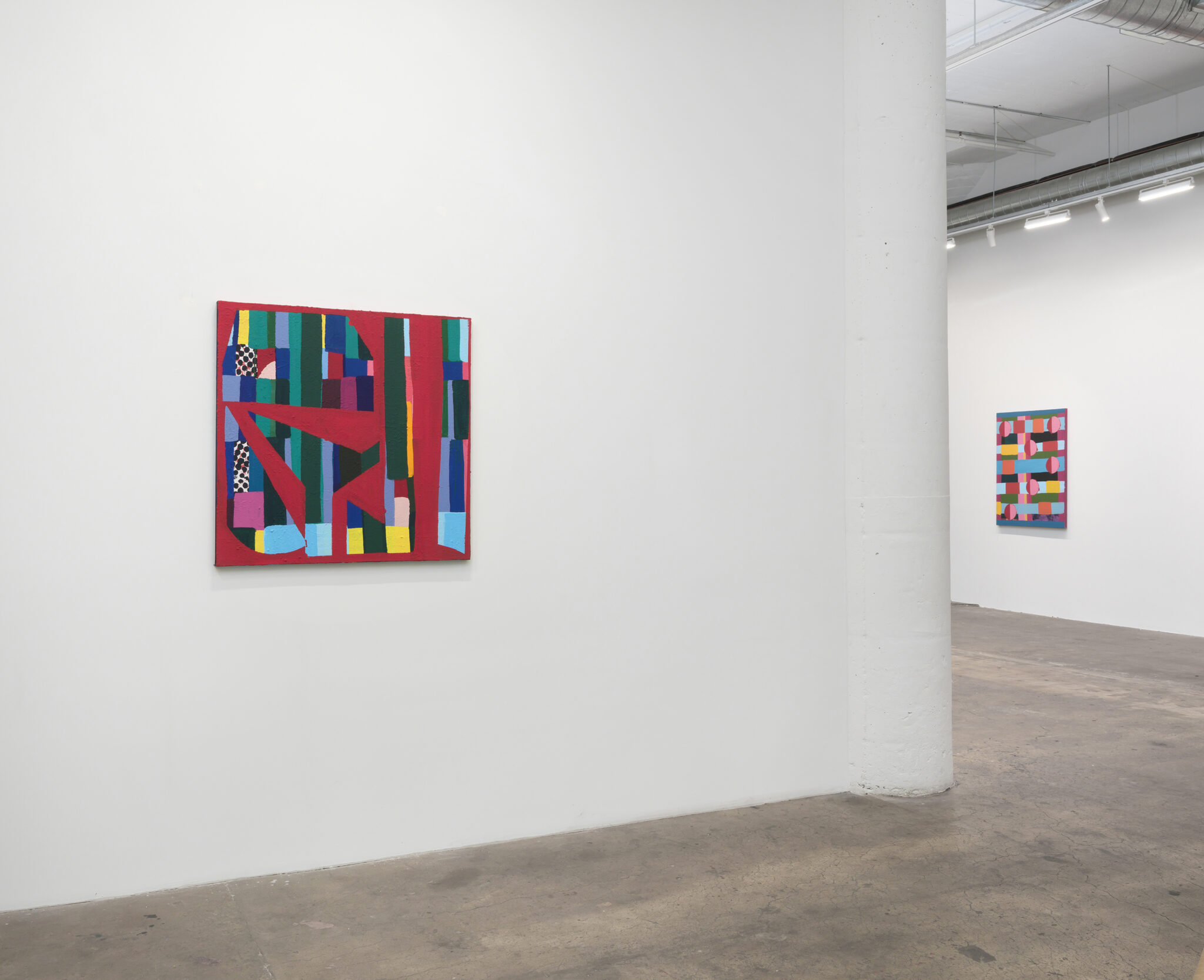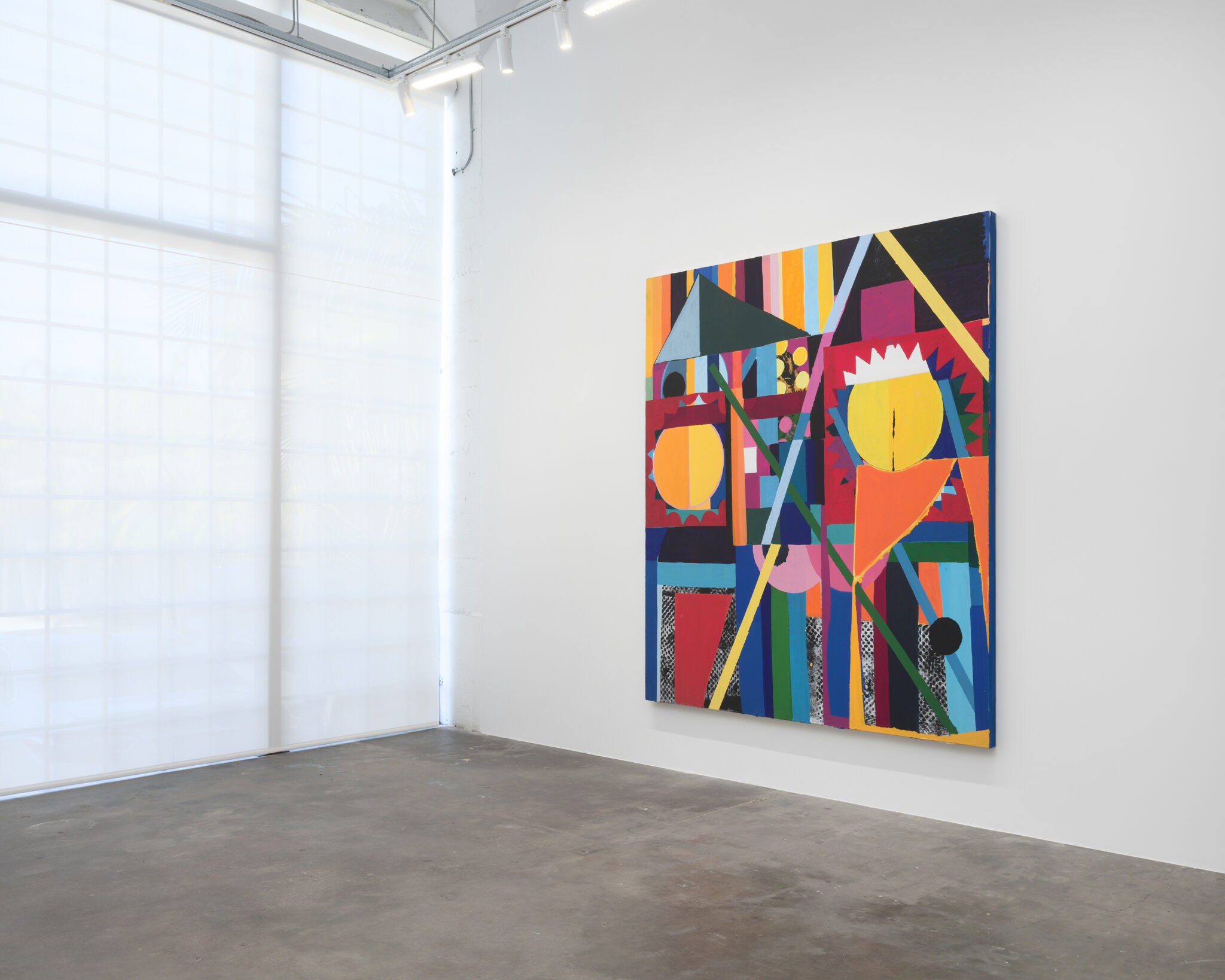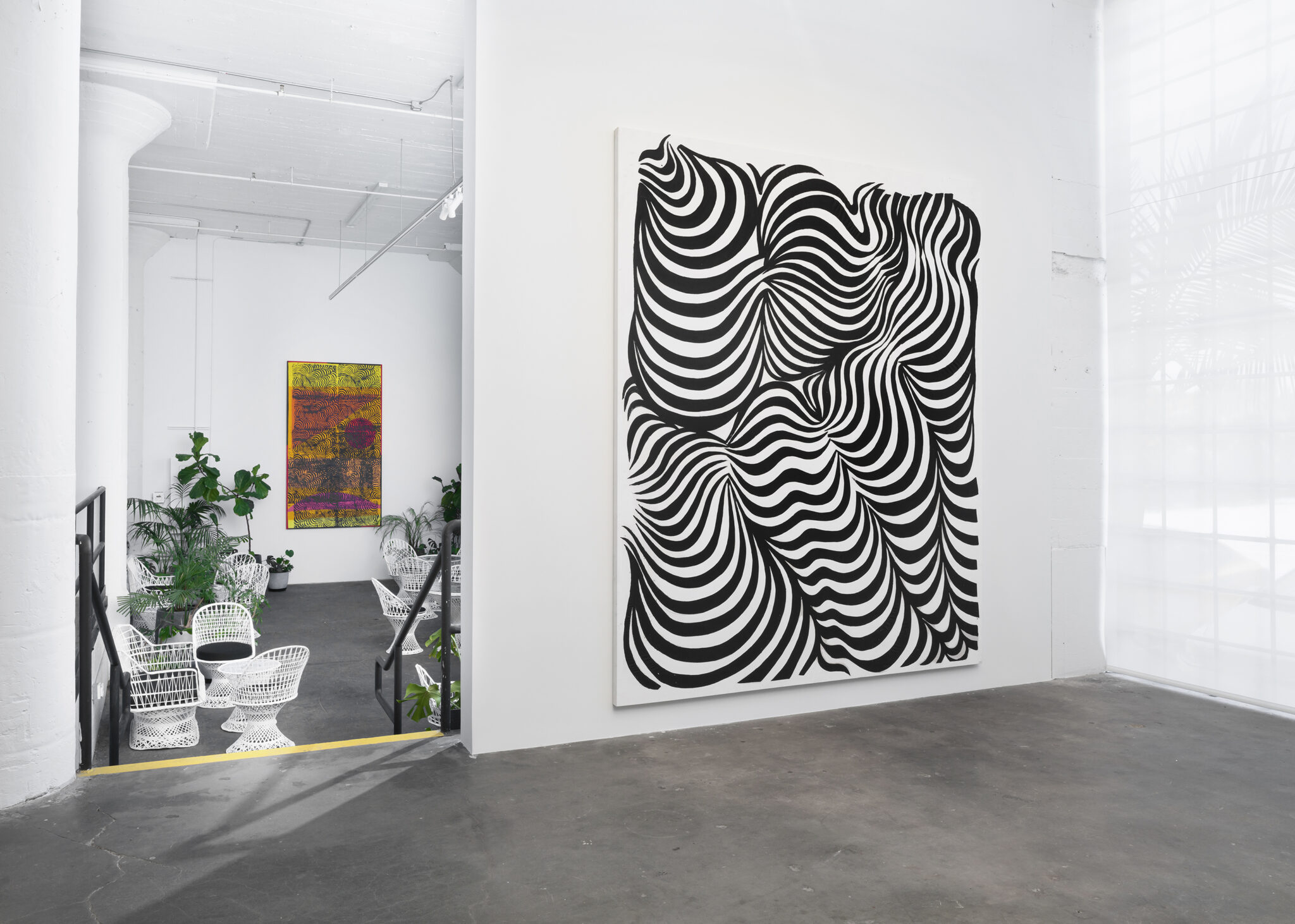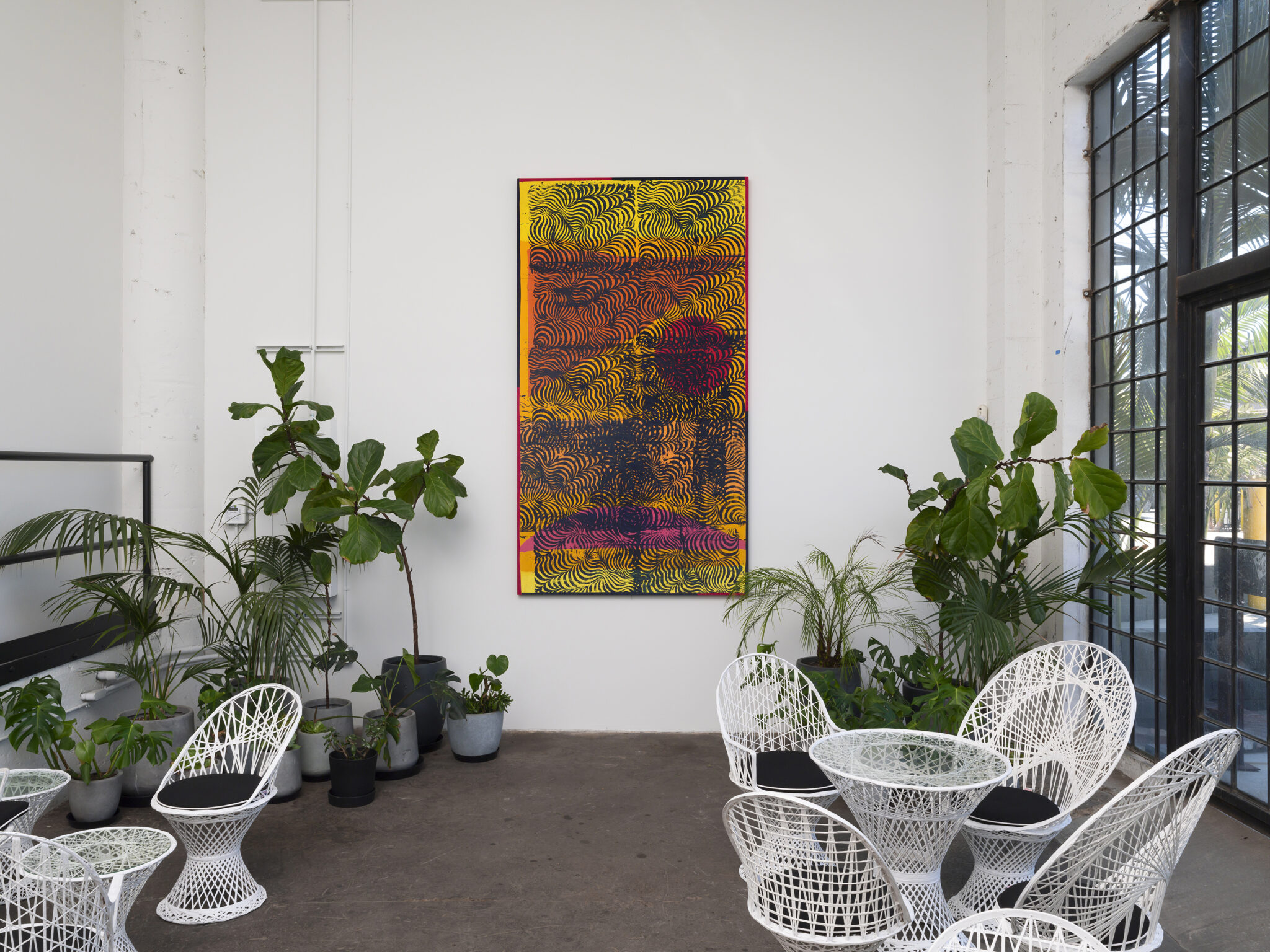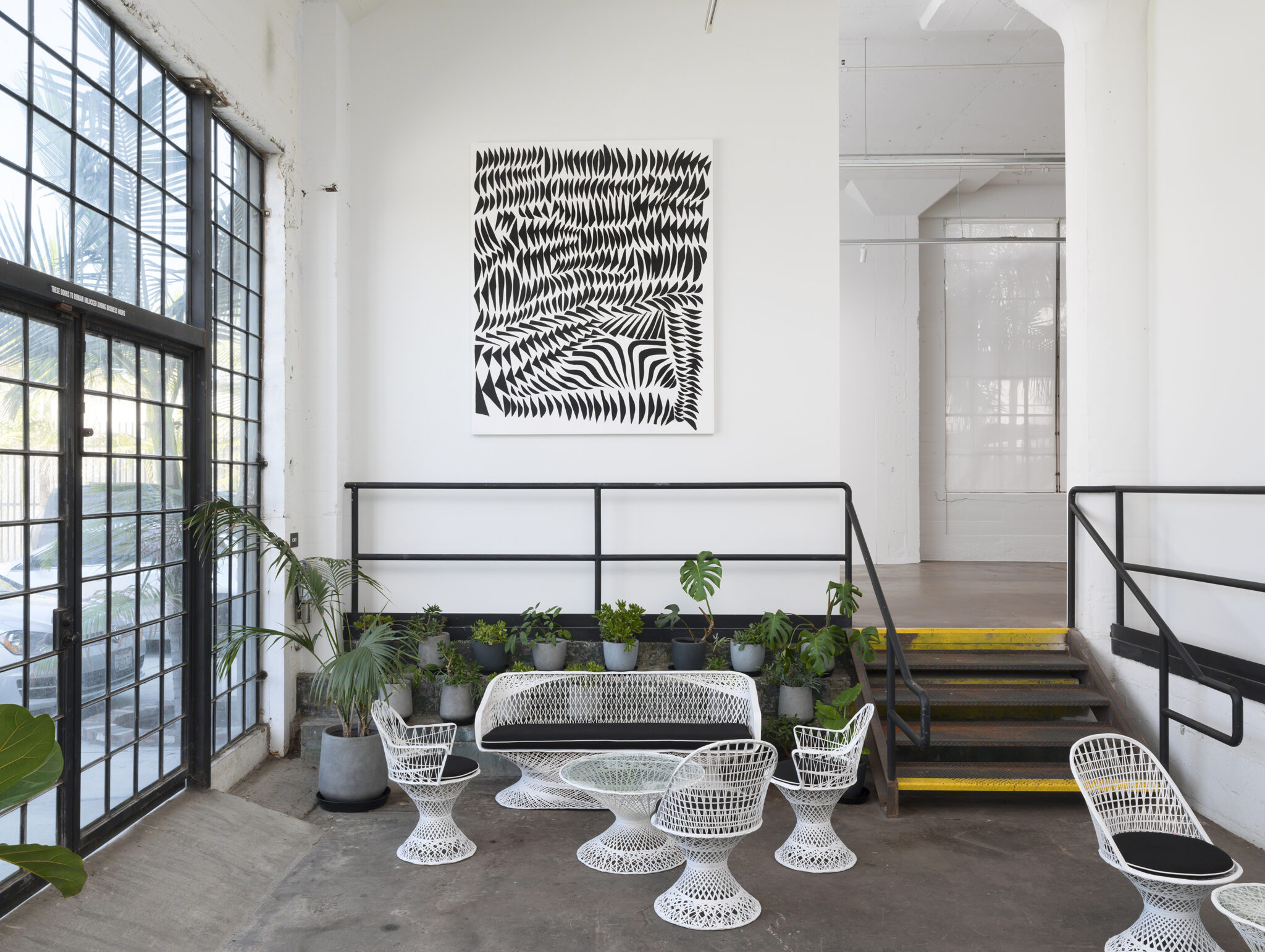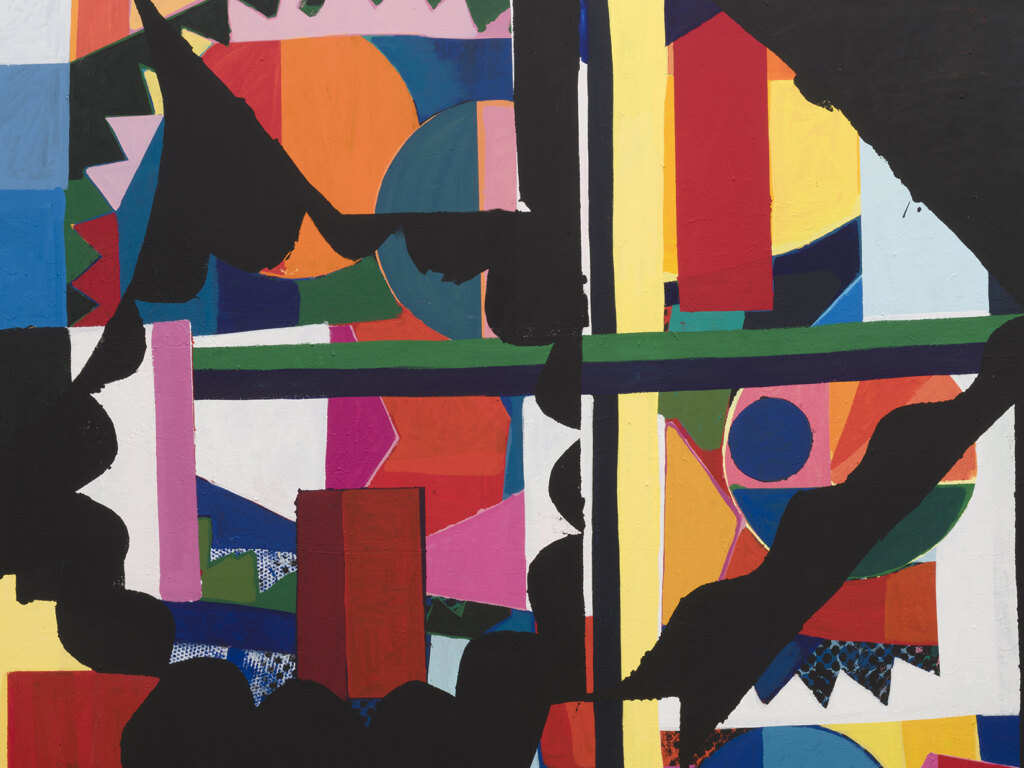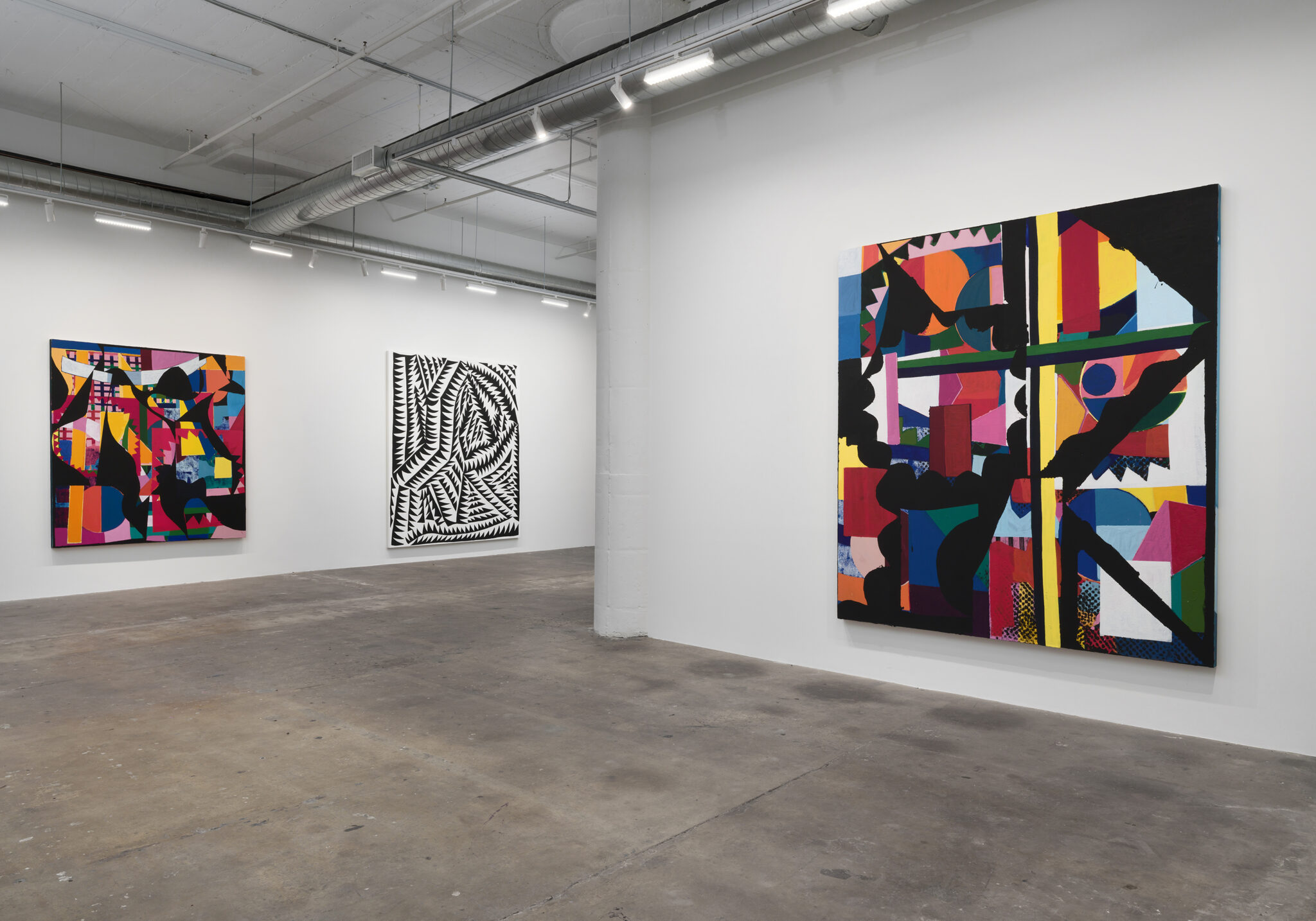

Installation photo credit: Jeff McLane
Opening Reception: Saturday, July 20, 4 – 7 pm
Vielmetter Los Angeles is pleased to announce Erasing A Flower, Nick Aguayo’s newest exhibition with the gallery, on view from July 20 to September 7, 2024.
I write, erase, rewrite.
Erase again, and then
A poppy blooms.
Inspired by Japanese artist and poet Katsushika Hokusai’s 18th-century haiku A Poppy Blooms, Nick Aguayo’s exhibition Erasing A Flower brings together two bodies of large-scale paintings: vividly colored abstractions and dynamic black and white paintings. Like the Hokusai poem, Aguayo’s color paintings bloom out of a repetition of “writing” and “erasing.” The structure of the colored paintings emerges through a continual building up and tearing down of a physical and pictorial vocabulary, while the black and white paintings originate in drawings he made during the pandemic.
Aguayo’s color abstractions reveal an inventive approach to the materiality and physicality of paint through densely coated collage-like patterning, thick impasto surfaces, textural areas of matte paint, and materials including marble dust. By brushing, pressing, rolling, and stenciling paint onto canvas, he builds compositions around the tensions between erasure and transparency, accumulation and excavation. The layered hand-rendered shapes—circle, sawtooth, halfmoon, dots, rectangles—appear in both positive and negative forms throughout the compositions.
The energy in Aguayo’s paintings stem from his explorations of figure/ground relationships, in particular, how the structural forms overlay and abut each other. He works on multiple panels at once, allowing this heightened energy to highlight change through repetition. Noting that he is “interested in the work carrying a vocabulary of shapes, marks, and methods that migrate between paintings as they are produced in concert and in conversation,” Aguayo expands on this as he considers his process:
I often think of the idea of a mark and its connection to the hand, and the idiosyncrasies of one’s hand. Masking, stenciling, and monotyping (pressing one painted surface against another surface as a means of reproduction and distortion) are used as a means of distancing and contrasting these direct idiosyncrasies of the hand. I am also interested in how these methods may amplify moments of chance and material outcomes that aren’t fully in my control. These moments of chance propel the work forward and decisions are based around the building of these moments. I’m interested in building and improvising a kind of intentionality through chance and process.
Aguayo frames the differences between the color and the black and white paintings in relation to music. He thinks of the color paintings as being “based largely on improvisation, and the black and white paintings as being scored or choreographed.” These black and white paintings represent a new direction for Aguayo and grew out of a series of drawings he completed during the pandemic. Unlike the oversized scale of his earlier color paintings, the drawings were modest, black and colored ink on sheets of ten-inch by eight-inch paper. He experimented with repetition, mark-making, and optical effects. As he investigated the relationships between form and color, the work became more geometric, with repeating loops dancing randomly across the page, or patterns of jagged forms lining up neatly next to each other. As he continued to explore, the work took on a quality reminiscent of Op art, a period of painting in the 1960s where artists used geometric forms to create optical effects. Aguayo’s new abstract paintings juxtapose black and white to create vibrating illusions of movement over the canvas. His work also references Franz Kline’s massive black and white paintings of improvised gestural notations and Kline’s practice of reworking smaller drawings.
Recently, Aguayo has widened his practice to expand his painterly vocabulary by experimenting with layered screen-printed compositions that incorporate screened drawings and collages. While he has regularly used masking and stenciling in his practice, he is now thinking about printmaking as an extension of painting. He shares that “it’s a different kind of mediation than the vocabulary of improvised shapes and marks in the color paintings…I’m interested in juxtaposing these two ways of making in order to see what each is made of and what they have in common.”
About the artist
Nick Aguayo was born in Palm Springs in 1984 and lives and works in Los Angeles. He received an MFA from the University of California, Irvine in 2012 and a BFA from UCLA in 2007. His work has been featured in exhibitions at New Mexico Museum of Art, Santa Fe, NM; Glendale Branch Library, Glendale, CA; Tamarisk Country Club, Rancho Mirage, CA; Shrine LA, Los Angeles; Over the Influence, Los Angeles; University of La Verne Art Gallery, La Verne, CA; Olong Gallery, Encinitas, CA; The Pit, Los Angeles; Samuel Freeman Gallery, Los Angeles; the Torrance Art Museum, Torrance, CA; Post Gallery, Los Angeles; LAXART, Los Angeles; Autonomie, Los Angeles; and the Armory Center for the Arts, Pasadena, CA. His work is in the collections of the Bronx Museum of Art, New York, and the Palm Springs Art Museum, Palm Springs, CA.
“Nails,” 2024
Acrylic and marble dust on muslin
102 ¹⁄₂" x 90" x 2" [HxWxD] (260.35 x 228.6 x 5.08 cm)
Inventory #AGU294
Courtesy of the artist and Vielmetter Los Angeles
Photo credit: Jeff McLane
![This image depicts an artwork by Nick Aguayo titled "Nails." This artwork was created in 2024 and measures 102 ¹⁄₂" x 90" x 2" [HxWxD] (260.35 x 228.6 x 5.08 cm). Its medium is Acrylic and marble dust on muslin.](https://vielmetter.com/wp-content/uploads/2024/07/Nick-Aguayo_AGU294_1721437290.jpg)
“Nails,” 2024
Acrylic and marble dust on muslin
102 ¹⁄₂" x 90" x 2" [HxWxD] (260.35 x 228.6 x 5.08 cm)
Inventory #AGU294
Courtesy of the artist and Vielmetter Los Angeles
Photo credit: Jeff McLane
“Procession,” 2024
Acrylic and marble dust on canvas
48" x 36" x 1 ¹⁄₂" [HxWxD] (121.92 x 91.44 x 3.81 cm)
Inventory #AGU302
Signed, dated, titled verso
Courtesy of the artist and Vielmetter Los Angeles
Photo credit: Jeff McLane
![This image depicts an artwork by Nick Aguayo titled "Procession." This artwork was created in 2024 and measures 48" x 36" x 1 ¹⁄₂" [HxWxD] (121.92 x 91.44 x 3.81 cm). Its medium is Acrylic and marble dust on canvas.](https://vielmetter.com/wp-content/uploads/2024/07/Nick-Aguayo_AGU302_1721437307.jpg)
“Procession,” 2024
Acrylic and marble dust on canvas
48" x 36" x 1 ¹⁄₂" [HxWxD] (121.92 x 91.44 x 3.81 cm)
Inventory #AGU302
Signed, dated, titled verso
Courtesy of the artist and Vielmetter Los Angeles
Photo credit: Jeff McLane
“Running away into you,” 2024
Acrylic and marble dust on canvas
86" x 80" x 2 ³⁄₄" [HxWxD] (218.44 x 203.2 x 6.99 cm)
Inventory #AGU311
Courtesy of the artist and Vielmetter Los Angeles
Photo credit: Jeff McLane
![This image depicts an artwork by Nick Aguayo titled "Running away into you." This artwork was created in 2024 and measures 86" x 80" x 2 ³⁄₄" [HxWxD] (218.44 x 203.2 x 6.99 cm). Its medium is Acrylic and marble dust on canvas.](https://vielmetter.com/wp-content/uploads/2024/07/Nick-Aguayo_AGU311_1721437320.jpg)
“Running away into you,” 2024
Acrylic and marble dust on canvas
86" x 80" x 2 ³⁄₄" [HxWxD] (218.44 x 203.2 x 6.99 cm)
Inventory #AGU311
Courtesy of the artist and Vielmetter Los Angeles
Photo credit: Jeff McLane
“Alligator Tears,” 2024
Acrylic and marble dust on muslin
107" x 93" x 2" [HxWxD] (271.78 x 236.22 x 5.08 cm)
Inventory #AGU292
Courtesy of the artist and Vielmetter Los Angeles
Photo credit: Jeff McLane
![This image depicts an artwork by Nick Aguayo titled "Alligator Tears." This artwork was created in 2024 and measures 107" x 93" x 2" [HxWxD] (271.78 x 236.22 x 5.08 cm). Its medium is Acrylic and marble dust on muslin.](https://vielmetter.com/wp-content/uploads/2024/07/Nick-Aguayo_AGU292_1721437347.jpg)
“Alligator Tears,” 2024
Acrylic and marble dust on muslin
107" x 93" x 2" [HxWxD] (271.78 x 236.22 x 5.08 cm)
Inventory #AGU292
Courtesy of the artist and Vielmetter Los Angeles
Photo credit: Jeff McLane
“Flying,” 2024
Acrylic and marble dust on muslin
113" x 93" x 2" [HxWxD] (287.02 x 236.22 x 5.08 cm)
Inventory #AGU293
Courtesy of the artist and Vielmetter Los Angeles
Photo credit: Jeff McLane
![This image depicts an artwork by Nick Aguayo titled "Flying." This artwork was created in 2024 and measures 113" x 93" x 2" [HxWxD] (287.02 x 236.22 x 5.08 cm). Its medium is Acrylic and marble dust on muslin.](https://vielmetter.com/wp-content/uploads/2024/07/Nick-Aguayo_AGU293_1721437362.jpg)
“Flying,” 2024
Acrylic and marble dust on muslin
113" x 93" x 2" [HxWxD] (287.02 x 236.22 x 5.08 cm)
Inventory #AGU293
Courtesy of the artist and Vielmetter Los Angeles
Photo credit: Jeff McLane
“Summer Knowledge,” 2024
Acrylic and marble dust on canvas
96" x 86" x 2 ³⁄₄" [HxWxD] (243.84 x 218.44 x 6.99 cm)
Inventory #AGU310
Courtesy of the artist and Vielmetter Los Angeles
Photo credit: Jeff McLane
![This image depicts an artwork by Nick Aguayo titled "Summer Knowledge." This artwork was created in 2024 and measures 96" x 86" x 2 ³⁄₄" [HxWxD] (243.84 x 218.44 x 6.99 cm). Its medium is Acrylic and marble dust on canvas.](https://vielmetter.com/wp-content/uploads/2024/07/Nick-Aguayo_AGU310_1721437381.jpg)
“Summer Knowledge,” 2024
Acrylic and marble dust on canvas
96" x 86" x 2 ³⁄₄" [HxWxD] (243.84 x 218.44 x 6.99 cm)
Inventory #AGU310
Courtesy of the artist and Vielmetter Los Angeles
Photo credit: Jeff McLane
“Crepuscule with Nelly,” 2024
Acrylic and marble dust on canvas
66" x 66" x 2 ³⁄₄" [HxWxD] (167.64 x 167.64 x 6.99 cm)
Inventory #AGU312
Courtesy of the artist and Vielmetter Los Angeles
Photo credit: Jeff McLane
![This image depicts an artwork by Nick Aguayo titled "Crepuscule with Nelly." This artwork was created in 2024 and measures 66" x 66" x 2 ³⁄₄" [HxWxD] (167.64 x 167.64 x 6.99 cm). Its medium is Acrylic and marble dust on canvas.](https://vielmetter.com/wp-content/uploads/2024/07/Nick-Aguayo_AGU312_1721437393.jpg)
“Crepuscule with Nelly,” 2024
Acrylic and marble dust on canvas
66" x 66" x 2 ³⁄₄" [HxWxD] (167.64 x 167.64 x 6.99 cm)
Inventory #AGU312
Courtesy of the artist and Vielmetter Los Angeles
Photo credit: Jeff McLane
“Lounge Lizard,” 2024
Acrylic and marble dust on canvas
40" x 30" x 1 ¹⁄₂" [HxWxD] (101.6 x 76.2 x 3.81 cm)
Inventory #AGU303
Signed, dated and titled verso
Courtesy of the artist and Vielmetter Los Angeles
Photo credit: Jeff McLane
![This image depicts an artwork by Nick Aguayo titled "Lounge Lizard." This artwork was created in 2024 and measures 40" x 30" x 1 ¹⁄₂" [HxWxD] (101.6 x 76.2 x 3.81 cm). Its medium is Acrylic and marble dust on canvas.](https://vielmetter.com/wp-content/uploads/2024/07/Nick-Aguayo_AGU303_1721437410.jpg)
“Lounge Lizard,” 2024
Acrylic and marble dust on canvas
40" x 30" x 1 ¹⁄₂" [HxWxD] (101.6 x 76.2 x 3.81 cm)
Inventory #AGU303
Signed, dated and titled verso
Courtesy of the artist and Vielmetter Los Angeles
Photo credit: Jeff McLane
“Elma,” 2024
Acrylic and marble dust on canvas
36" x 36" x 2" [HxWxD] (91.44 x 91.44 x 5.08 cm)
Inventory #AGU315
Courtesy of the artist and Vielmetter Los Angeles
Photo credit: Jeff McLane
![This image depicts an artwork by Nick Aguayo titled "Elma." This artwork was created in 2024 and measures 36" x 36" x 2" [HxWxD] (91.44 x 91.44 x 5.08 cm). Its medium is Acrylic and marble dust on canvas.](https://vielmetter.com/wp-content/uploads/2024/07/Nick-Aguayo_AGU315_1721437426.jpg)
“Elma,” 2024
Acrylic and marble dust on canvas
36" x 36" x 2" [HxWxD] (91.44 x 91.44 x 5.08 cm)
Inventory #AGU315
Courtesy of the artist and Vielmetter Los Angeles
Photo credit: Jeff McLane
“Gasoline,” 2024
Acrylic and marble dust on canvas
96" x 86" x 2 ³⁄₄" [HxWxD] (243.84 x 218.44 x 6.99 cm)
Inventory #AGU309
Courtesy of the artist and Vielmetter Los Angeles
Photo credit: Jeff McLane
![This image depicts an artwork by Nick Aguayo titled "Gasoline." This artwork was created in 2024 and measures 96" x 86" x 2 ³⁄₄" [HxWxD] (243.84 x 218.44 x 6.99 cm). Its medium is Acrylic and marble dust on canvas.](https://vielmetter.com/wp-content/uploads/2024/07/Nick-Aguayo_AGU309_1721437440.jpg)
“Gasoline,” 2024
Acrylic and marble dust on canvas
96" x 86" x 2 ³⁄₄" [HxWxD] (243.84 x 218.44 x 6.99 cm)
Inventory #AGU309
Courtesy of the artist and Vielmetter Los Angeles
Photo credit: Jeff McLane
“New High Street,” 2024
Acrylic and marble dust on canvas
108" x 86" [HxW] (274.32 x 218.44 cm)
Inventory #AGU297
Courtesy of the artist and Vielmetter Los Angeles
Photo credit: Jeff McLane
![This image depicts an artwork by Nick Aguayo titled "New High Street." This artwork was created in 2024 and measures 108" x 86" [HxW] (274.32 x 218.44 cm). Its medium is Acrylic and marble dust on canvas.](https://vielmetter.com/wp-content/uploads/2024/07/Nick-Aguayo_AGU297_1721437456.jpg)
“New High Street,” 2024
Acrylic and marble dust on canvas
108" x 86" [HxW] (274.32 x 218.44 cm)
Inventory #AGU297
Courtesy of the artist and Vielmetter Los Angeles
Photo credit: Jeff McLane
“Head,” 2024
Acrylic and marble dust on canvas
48" x 36" x 1 ¹⁄₂" [HxWxD] (121.92 x 91.44 x 3.81 cm)
Inventory #AGU300
Signed, dated and titled verso
Courtesy of the artist and Vielmetter Los Angeles
Photo credit: Jeff McLane
![This image depicts an artwork by Nick Aguayo titled "Head." This artwork was created in 2024 and measures 48" x 36" x 1 ¹⁄₂" [HxWxD] (121.92 x 91.44 x 3.81 cm). Its medium is Acrylic and marble dust on canvas.](https://vielmetter.com/wp-content/uploads/2024/07/Nick-Aguayo_AGU300_1721437469.jpg)
“Head,” 2024
Acrylic and marble dust on canvas
48" x 36" x 1 ¹⁄₂" [HxWxD] (121.92 x 91.44 x 3.81 cm)
Inventory #AGU300
Signed, dated and titled verso
Courtesy of the artist and Vielmetter Los Angeles
Photo credit: Jeff McLane
“Lexicon Devil,” 2024
Acrylic and marble dust on muslin
87" x 72" x 2" [HxWxD] (220.98 x 182.88 x 5.08 cm)
Inventory #AGU291
Courtesy of the artist and Vielmetter Los Angeles
Photo credit: Jeff McLane
![This image depicts an artwork by Nick Aguayo titled "Lexicon Devil." This artwork was created in 2024 and measures 87" x 72" x 2" [HxWxD] (220.98 x 182.88 x 5.08 cm). Its medium is Acrylic and marble dust on muslin.](https://vielmetter.com/wp-content/uploads/2024/07/Nick-Aguayo_AGU291_1721437479.jpg)
“Lexicon Devil,” 2024
Acrylic and marble dust on muslin
87" x 72" x 2" [HxWxD] (220.98 x 182.88 x 5.08 cm)
Inventory #AGU291
Courtesy of the artist and Vielmetter Los Angeles
Photo credit: Jeff McLane
“Elysian,” 2024
Acrylic and marble dust on canvas
112" x 62" x 2" [HxWxD] (284.48 x 157.47 x 5.08 cm)
Inventory #AGU308
Courtesy of the artist and Vielmetter Los Angeles
Photo credit: Jeff McLane
![This image depicts an artwork by Nick Aguayo titled "Elysian." This artwork was created in 2024 and measures 112" x 62" x 2" [HxWxD] (284.48 x 157.47 x 5.08 cm). Its medium is Acrylic and marble dust on canvas.](https://vielmetter.com/wp-content/uploads/2024/07/Nick-Aguayo_AGU308_1721437509.jpg)
“Elysian,” 2024
Acrylic and marble dust on canvas
112" x 62" x 2" [HxWxD] (284.48 x 157.47 x 5.08 cm)
Inventory #AGU308
Courtesy of the artist and Vielmetter Los Angeles
Photo credit: Jeff McLane
